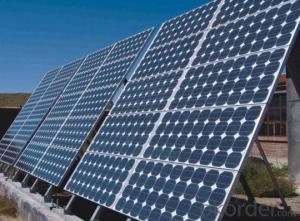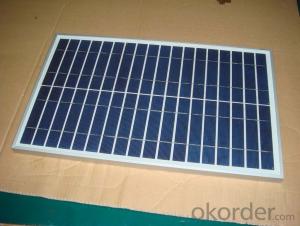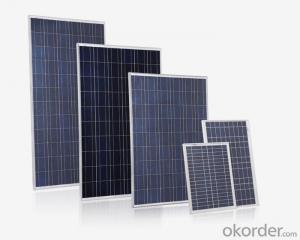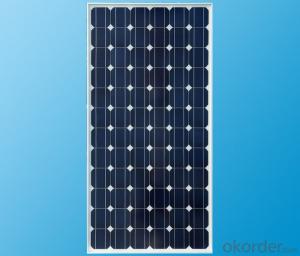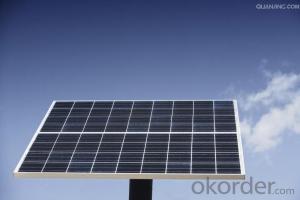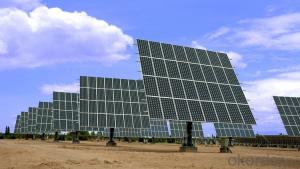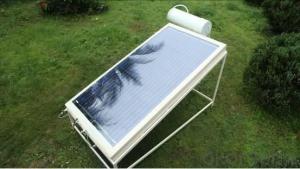Favorites Compare 140w 150w 260w polycrystalline solar panel,polycrystalline silicon solar panel for building automation system
- Loading Port:
- China Main Port
- Payment Terms:
- TT OR LC
- Min Order Qty:
- -
- Supply Capability:
- 10000000000000 watt/month
OKorder Service Pledge
OKorder Financial Service
You Might Also Like
Quick Details
| Place of Origin: | Guangdong China (Mainland) | Brand Name: | CAP | Model Number: | 50w100w150w200w250w300w |
| Material: | Monocrystalline Silicon | Size: | 1385*1035*75mm | Number of Cells: | 72pcs |
| Max. Power: | 300w | type: | solar panel | color: | blue&black |
| warranty: | 5 years |
Packaging & Delivery
| Packaging Detail: | standard export package for solar panel |
| Delivery Detail: | 7-15 days for solar panel |
Specifications
solar panel
High Efficiency
25 years Warranty
High-transmissivity low-iron tempered glass
Solar Panel
50w100w150w200w250w300w
Characteristics
1,High and stable conversion efficienly based on over 4 years professional experience
2 ,High reliability with guaranteed +/-10% output power tolerance
3,Proven materials,tempered front glass,and a sturdy anodized aluminum frame allow modules to operate reliably in multiple mountily configurations
4,Combination of high efficicncy and attractive appearance
Quality and Safety
1,25 year 80%,10 year 90% power warranty 3 year power warranty
2,ISO9001:2000 (Quality Management system) certified factory
3,Product Quality warranty & products Liability Insurance to guarantee and user' benefits
4,Certifications TUV Intercert, CE Temperature Coefficients
| Module Type | 100w | 150w | 200w | 250w | 300w |
| Maximum Power at ST(Pmax)W | 100wp | 150wp | 200wp | 250wp | 300wp |
| Maximum Power Voltage(Vmp)V | 36/18 | 36/18 | 36/18 | 30.8v | 36/18 |
| Maximum Power Current(Imp)A | 2.77/5.55 | 4.16/8.33 | 5.55/11.1 | 8.11A | 8.33/16.66 |
| Open Circuit Voltage(Voc)V | 39.5/19.05 | 39.3/19.4 | 39.6/19.5 | 36.2V | 39.6/19.8 |
| Short Circuit Current(Isc)A | 3.04/6.09 | 4.58/9.16 | 6.1/12.2 | 8.7A | 9.16/18.33 |
| Cell Efficiency(%) | 18.60% | 18.10% | 18.60% | 17.80% | 18.10% |
| Module Efficiency(%) | 17.70% | 17.20% | 17.70% | 17.10% | 17.20% |
| Operating Temperature°C | -40°C to +85°C | -40°C to +85°C | -40°C to +85°C | -40°C to +85°C | -40°C to +85°C |
| Maximum system voltage | 1000V(IEC)DC | 1000V(IEC)DC | 1000V(IEC)DC | 1000V(IEC)DC | 1000V(IEC)DC |
| Power tolerance | -0.03 | -0.03 | -0.03 | -0.03 | -0.03 |
| Temperature coefficients of Pmax | -0.45%/°C | -0.45%/°C | -0.45%/°C | -0.45%/°C | -0.45%/°C |
| Temperature coefficients of Voc | -0.27%/°C | -0.27%/°C | -0.27%/°C | -0.27%/°C | -0.27%/°C |
| Temperature coefficients of Isc | 0.05%/°C | 0.05%/°C | 0.05%/°C | 0.05%/°C | 0.05%/°C |
| Weight(kg) | 8 | 11 | 14 | 20 | 25.5 |
| Number of cell(pcs) | 4*9 | 4*9 | 6*10 | 6*12 | 6*12 |
| Dimensions(mm) | 1194*534*35/30 | 1580*808*50/35 | 1471*670*40/35 | 1640*992*50 | 2000*1050*50 |
- Q:How do solar cells handle hail or other severe weather conditions?
- Solar cells are designed to withstand severe weather conditions, including hail. They are made with durable materials such as tempered glass or other shatter-resistant materials that can withstand impacts. Additionally, solar panels undergo rigorous testing to ensure their ability to withstand hailstorms and other harsh weather conditions.
- Q:Can solar cells be used for powering remote research stations in Antarctica?
- Yes, solar cells can be used for powering remote research stations in Antarctica. Solar cells are a sustainable and reliable source of energy that can harness the abundant sunlight available in Antarctica during the summer months. They can provide a consistent power supply to run essential equipment and facilities at remote research stations, reducing the dependence on fossil fuels and minimizing the environmental impact. Additionally, advancements in solar technology have improved the efficiency and durability of solar cells, making them a viable option for powering these isolated stations in extreme conditions.
- Q:What is the role of anti-reflective coatings on solar cells?
- The role of anti-reflective coatings on solar cells is to minimize the amount of light that is reflected away from the surface of the cell. By reducing reflection, these coatings allow more light to be absorbed by the solar cell, increasing its efficiency and overall power output.
- Q:Can solar cells be used in telecommunications infrastructure?
- Yes, solar cells can be used in telecommunications infrastructure. They can provide a reliable and sustainable power source for various telecom equipment such as mobile phone towers, repeaters, and base stations. Solar cells are particularly suitable for remote or off-grid areas where access to conventional power sources is limited. Additionally, their installation can reduce operational costs and environmental impact, making them an increasingly popular choice in the telecommunications industry.
- Q:What is the impact of wind on solar cell efficiency?
- The impact of wind on solar cell efficiency is generally minimal. While wind can cause slight vibrations or movements in solar panels, it does not significantly affect the overall efficiency of the cells. The main factors that influence solar cell efficiency are the angle and orientation of the panels towards the sun, as well as the amount of sunlight received.
- Q:Can solar cells be used for powering satellites?
- Yes, solar cells can be used for powering satellites. In fact, they are one of the most common and efficient methods of generating electricity in space. Solar cells convert sunlight directly into electricity, which is then used to power various systems and instruments onboard a satellite.
- Q:Can solar cells be used in satellite or space exploration missions?
- Yes, solar cells can be and have been used in satellite or space exploration missions. Solar cells convert sunlight directly into electricity, making them a reliable and efficient source of power for satellites and space probes. They are lightweight, durable, and ideal for harnessing energy in space where traditional power sources are not feasible.
- Q:What is the impact of saltwater exposure on solar cell efficiency?
- Saltwater exposure can have a significant negative impact on solar cell efficiency. The saltwater can corrode the metal components of the solar cells, leading to a decrease in their performance and overall efficiency. Additionally, the saltwater can create a conductive pathway that can bypass the solar cells, resulting in a loss of electrical energy. Therefore, it is crucial to protect solar cells from saltwater exposure to maintain their efficiency and prolong their lifespan.
- Q:Can solar cells be used for water desalination?
- Yes, solar cells can be used for water desalination. Solar energy can be harnessed by solar cells to power the desalination process, typically through either photovoltaic or solar thermal technologies. This enables the conversion of seawater or brackish water into fresh water by removing the salt and other impurities, making solar-powered desalination a sustainable and eco-friendly solution for addressing water scarcity in coastal regions.
- Q:What is the typical warranty for solar cells?
- The typical warranty for solar cells ranges from 10 to 25 years, depending on the manufacturer and type of solar cell.
1. Manufacturer Overview |
|
|---|---|
| Location | |
| Year Established | |
| Annual Output Value | |
| Main Markets | |
| Company Certifications | |
2. Manufacturer Certificates |
|
|---|---|
| a) Certification Name | |
| Range | |
| Reference | |
| Validity Period | |
3. Manufacturer Capability |
|
|---|---|
| a)Trade Capacity | |
| Nearest Port | |
| Export Percentage | |
| No.of Employees in Trade Department | |
| Language Spoken: | |
| b)Factory Information | |
| Factory Size: | |
| No. of Production Lines | |
| Contract Manufacturing | |
| Product Price Range | |
Send your message to us
Favorites Compare 140w 150w 260w polycrystalline solar panel,polycrystalline silicon solar panel for building automation system
- Loading Port:
- China Main Port
- Payment Terms:
- TT OR LC
- Min Order Qty:
- -
- Supply Capability:
- 10000000000000 watt/month
OKorder Service Pledge
OKorder Financial Service
Similar products
New products
Hot products
Hot Searches
Related keywords
